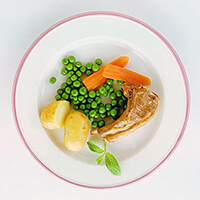 The Less, The Better!
The Less, The Better!
When food tastes good, it’s hard to pay attention to how much you’re eating. If you are the type of person who eats more than they should, you probably are more prone to gaining excess body fat! This is why it is very important to pay attention to your portion sizes, so that you can maintain a healthy weight and be satisfied with the food you eat for every meal. Because overtime, our bodies are going to adapt to the amounts of food we eat, therefore, the more we eat the more our bodies are going to want more food!
Research has shown that we often eat more when we are presented with larger portions. For some reason, over the past couple of decades the portions sizes that are presented to us are increasing. Those 7 ounce soda bottles that we used to consume, have now increased to 20 ounces going from 85 calories to 250 calories. And do you ever notice muffins these days? They are so large these days that the way people used to eat them before is half the size of them now! Below are some tips and tricks to help you make sure you pay attention to your portion sizes!
How To Pay Attention To Your Portion Sizes?
Being aware of your portion sizes is the first step into helping you maintain your healthy weight and if you’re someone who is already heavy set; it will also help you to lose weight. Your body will adapt to the amount of food you consume during each meal.
- Know your numbers. Start by learning how to figure out how many calories are right for you. There are thousands of tools out there that can help you determine this number.
- Focus on nutrition. Your largest portions should include vegetables and fruits that provide large doses of nutrients, such as vitamins, minerals, antioxidants and fiber. Your smaller portions should include higher calorie foods, such as sweets and foods that have high amounts of sugar and fats.
- Understand serving size vs portion size. The difference between the two is a portion is the amount you choose to eat, where as a serving is a precise amount of food defined by cups, ounces, grams or other measurement. Most serving sizes will be found on food labels.
- Learn visual cues for serving sizes. These can help you define your servings. For example, a hockey puck is about the size of 1/2 bagel, 1/2 of pasta or 1/2 cup of dried cereal.
- Eat mindfully and enjoy your food. Our emotions tend encourage our eating behaviors. Such as happiness or sadness/stress or being distracted by a TV, computer or phone. These types of emotions can lead you to eating larger portion sizes.
Tips For Staying Motivated On Portion Sizes:
When you’re at home:
- Make sure to see what the recommended portion sizes of food you eat look like in the bowls, plates, and glasses you use at home.
- Use smaller plates and glasses to serve foods.
- Serve foods on plates in the kitchen and then eat at the table.
When you’re out to eat:
- Try and share a restaurant meal with a friend or family member.
- Ask for a take home bag and wrap up half your meal to take home before you start to eat.
- Order a healthy appetizer as your mean instead of an entree.
- Avoid trying to supersize you meal or buying combo meals.
In general:
- Eat a healthy snack between meals.
- Measure pre-portioned snacks in baggies for a quick, grab and go treat.
- Make half of your plate fruits and vegetables.
- If you’re still hungry after a meal, wait at least 10 to 15 minutes if you are thinking about a second helping.
